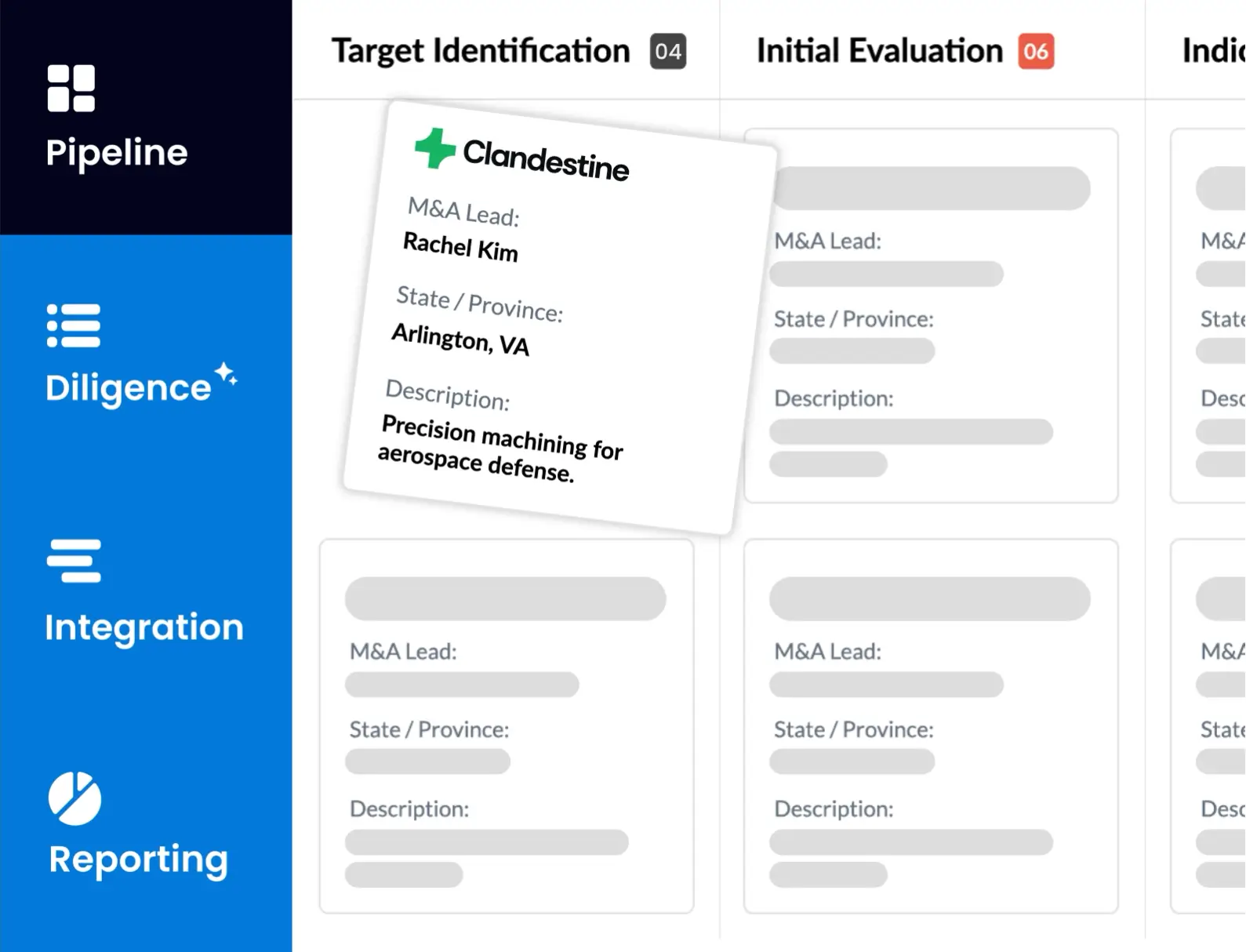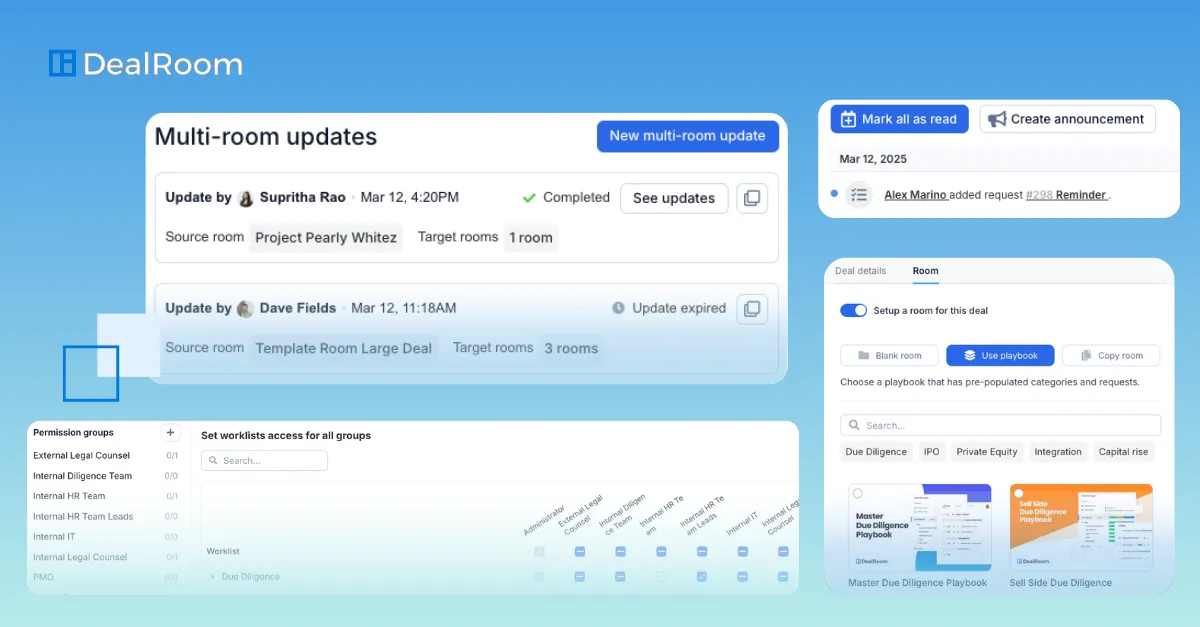When companies want to acquire other businesses, they often hire specialized investment banks to guide them through the complex process. Buy-side M&A advisory services help acquiring companies identify targets, conduct due diligence, negotiate deals, and close transactions successfully. These advisors work exclusively for the buyer, providing strategic guidance and financial expertise throughout the entire acquisition process.
Buy-side advisors play a crucial role in M&A success. They help companies navigate regulatory requirements, value potential targets, and structure deals that create maximum value. Unlike sell-side advisors who represent the company being sold, buy-side advisors focus solely on the acquirer's interests and objectives.
The buy-side advisory process involves multiple stages, from initial target identification to final closing.
In this article:
- Buy-Side M&A Advisory Responsibilities
- Buy-Side Advisory vs. Sell-Side Advisory
- Strategic Importance for Acquiring Companies
- The Buy-Side M&A Advisory Process
- Key Stages in Buy-Side Due Diligence
- Negotiation and Closing the Transaction
- Special Considerations and Sector Expertise
- Frequently Asked Questions
- Key Takeaways
What Is Buy-Side M&A Advisory?
Buy-side M&A advisory represents specialized financial services that guide acquiring companies through complex M&A transactions. These advisors help buyers identify targets, structure deals, and navigate the buy-side M&A process from initial planning through deal completion.
Buy-Side M&A Advisory Responsibilities

Buy-side advisory services offer comprehensive support for companies seeking to acquire other businesses. Investment banks and financial advisors working on the buy-side represent the acquiring company's interests throughout the transaction process.
These advisors perform multiple critical functions. They conduct target identification and screening to find suitable acquisition candidates. Buy-side M&A advisory teams also handle financial modeling and valuation analysis to determine fair acquisition prices.
Key buy-side advisory responsibilities include:
- Due diligence coordination and management
- Deal structure optimization and financing arrangements
- Negotiation support with target companies
- Regulatory approval assistance
- Post-merger integration planning
The advisory team usually includes investment bankers, analysts, and industry specialists. They bring deep expertise in specific sectors and transaction types to maximize deal success probability.
Buy-Side Advisory vs. Sell-Side Advisory
The fundamental difference between buy-side advisory and sell-side advisory lies in client representation and objectives. Buy-side advisors work exclusively for acquiring companies, while sell-side advisors represent companies being sold.
Buy-side advisors focus on:
- Minimizing acquisition costs and premiums
- Identifying strategic synergies and value creation opportunities
- Structuring deals to benefit the acquirer
- Managing integration risks and challenges
Sell-side advisors prioritize:
- Maximizing sale price and deal terms
- Creating competitive bidding situations
- Presenting the target company favorably
- Negotiating optimal conditions for sellers
Research shows that socially connected advisors help acquirers pay lower premiums in M&A transactions. This demonstrates how advisor relationships and networks can directly impact deal outcomes for buyers.
The compensation structures also differ significantly. Buy-side advisors typically receive fees based on deal completion and sometimes ongoing success metrics.
Strategic Importance for Acquiring Companies
Buy-side advisory services provide critical value beyond basic transaction execution. They help companies avoid costly acquisition mistakes and identify deals that create genuine shareholder value.
Professional advisors bring extensive market knowledge and transaction experience. They understand industry dynamics, competitive landscapes, and valuation benchmarks that individual companies may lack internally.
Strategic benefits include:
- Risk mitigation through comprehensive due diligence processes
- Market access to off-market and exclusive deal opportunities
- Negotiation leverage through experienced deal professionals
- Integration support to realize projected synergies
Studies indicate that utilizing proper valuation models and financing methods can significantly enhance post-acquisition performance.
Companies lacking internal M&A expertise particularly benefit from external advisory support. Buy-side M&A advisory teams offer specialized knowledge to help buyers navigate the complex regulatory environment and sophisticated deal structures.
The Buy-Side M&A Advisory Process

The buy-side process for identifying, accessing, and facilitating successful M&A transactions involves three critical phases that guide acquiring companies through complex deal negotiations. These stages establish clear acquisition goals, systematically evaluate potential targets, and develop competitive offers that maximize the probability of deal success.
Initial Consultation and Objective Setting
Strategic Planning Phase
Buy-side advisors begin by conducting comprehensive interviews with management teams to understand acquisition motivations. They analyze the client's current market position, growth objectives, and financial capacity for transactions.
Key areas of focus include:
- Revenue targets and market expansion goals
- Synergy expectations from potential acquisitions
- Integration capabilities within existing operations
- Risk tolerance levels for deal complexity
Financial Parameters
Advisors establish clear financial boundaries for the acquisition search by reviewing the client's balance sheet strength, available financing options, and return on investment requirements. Deal size parameters typically range from specific minimum thresholds to maximum transaction values. These constraints help narrow the universe of potential targets and focus search efforts effectively.
Timeline Development
The advisory team creates realistic timelines for target identification, due diligence periods, and expected closing dates. Most buy-side processes require 6-12 months from initial consultation to transaction completion.
Target Company Identification
Market Screening Process
Advisors utilize proprietary databases and industry networks to identify companies matching the client’s criteria. They analyze market segments, competitive landscapes, and growth trajectories of potential targets.
The screening process evaluates:
- Financial performance metrics and stability
- Strategic fit with acquirer objectives
- Management quality and operational efficiency
- Market position and competitive advantages
Preliminary Valuation Analysis
Investment bankers conduct initial business valuation assessments using comparable company analysis and precedent transactions. This establishes realistic pricing expectations before formal negotiations begin.
Target company financial modeling includes revenue projections, EBITDA multiples, and potential synergy quantification. These models help prioritize prospects based on value creation potential.
Confidential Outreach
Advisors initiate discrete contact with the target company’s management or representatives. Initial discussions focus on strategic rationale and preliminary interest levels without revealing the buyer’s identity.
Deal Structuring and Offer Preparation
Valuation Methodology
Buy-side advisors develop comprehensive valuation models using multiple methodologies, balancing discounted cash flow (DCF) analysis with market-based approaches to establish fair value ranges. Business valuation considerations include:
- Historical financial performance trends
- Future growth prospects and market conditions
- Synergy realization timelines and probability
- Integration costs and execution risks
Offer Structure Design
Advisors structure offers to align with both buyer objectives and seller expectations. They evaluate cash versus stock considerations, contingent payouts to mitigate adverse selection risks, and closing condition requirements.
Payment structures often include earnout provisions tied to future performance metrics. These arrangements help bridge valuation gaps between buyers and sellers.
Negotiation Strategy
The advisory team develops negotiation frameworks addressing key deal terms. They prepare management presentations, supporting financial analysis, and response strategies for potential counteroffers.
Mergers and acquisitions negotiations require a careful balance between competitive positioning and relationship preservation throughout the process.
Key Stages in Buy-Side Due Diligence

Successful buy-side due diligence requires systematic evaluation across three critical areas. Teams must analyze financial data, assess operational capabilities, and identify potential risks before completing transactions.
Financial Statement Analysis
Financial due diligence forms the foundation of buy-side due diligence. Acquirers examine three to five years of audited financial statements to understand the target's performance patterns.
The table below highlights key financial metrics and why they’re important.
Teams verify revenue recognition policies and accounting practices. They look for one-time events that might distort normal business performance. Cash flow statements receive particular attention since they show actual money movement.
In addition to these metrics, buyers analyze the quality of earnings by adjusting for non-recurring items. They identify revenue concentration risks and customer dependency issues, evaluating seasonal patterns and cyclical trends to help predict future performance.
Financial projections require scrutiny against historical results. Buy-side M&A advisory teams also compare management forecasts with industry benchmarks and market conditions.
Operational and Legal Assessment
Operational due diligence examines how the target company actually runs its business, while legal due diligence identifies potential liabilities and compliance issues that could impact the deal value.
Operational review areas include:
- Management team capabilities and retention plans
- Technology systems and infrastructure needs
- Supply chain dependencies and vendor relationships
- Customer contracts and retention rates
- Market position and competitive advantages
Legal teams review material contracts, litigation history, and regulatory compliance records. They also examine employment agreements, intellectual property rights, and environmental liabilities.
Industry Analysis
Teams evaluate industry trends affecting the target's future prospects, assessing market growth rates, competitive dynamics, and regulatory changes. Technology disruption risks receive careful consideration.
Operational synergies are also quantified during this stage. Buyers identify cost reduction opportunities and revenue enhancement potential from combining operations.
Risk Evaluation and Mitigation
Risk evaluation identifies threats that could impact deal success or post-acquisition performance. Due diligence teams categorize risks by probability and potential impact.
Some of the major risk categories buyers should consider include:
- Financial risks - Cash flow volatility, debt covenant violations, tax liabilities
- Operational risks - Key person dependency, system integration challenges, cultural conflicts
- Market risks - Industry decline, competitive threats, regulatory changes
- Legal risks - Pending litigation, compliance violations, contract disputes
If risks are identified, teams develop mitigation strategies to address them. For example, some risks get addressed through purchase price adjustments or escrow arrangements, while others require specific post-closing action plans.
Deal Structure Implications
Risk findings can shape the structure of the deal. High-risk areas might prompt buyers to negotiate additional seller warranties or specific indemnities, extend escrow periods, or increase purchase-price holdbacks.
Some exposure can be shifted to third parties. For example, representations and warranties (R&W) insurance is now a common tool for managing unknown breaches and liabilities. These insurance policies typically exclude known issues.
Negotiation and Closing the Transaction

The final phase of buy-side M&A advisory involves detailed negotiations on deal terms and the completion of all legal requirements. Advisory services guide buyers through complex price discussions, contract terms, and regulatory approvals needed to close successfully.
Negotiating Terms and Deal Structure
Buy-side advisors help buyers negotiate key deal terms that protect their interests and maximize value. The negotiation process covers purchase price, payment structure, and risk allocation between parties.
Purchase price components include:
- Base purchase price
- Earnout provisions
- Working capital adjustments
- Escrow arrangements
Advisory teams work to structure favorable payment terms. For instance, they may negotiate lower upfront payments with performance-based earnouts tied to future results.
Risk allocation becomes critical during negotiations. Buyers want strong representations and warranties from sellers. Advisors push for longer survival periods and higher liability caps on these protections.
Buy-side advisors strengthen negotiating leverage through detailed preparation and market knowledge. They identify deal breakers early and develop fallback positions for key terms.
Advisors also negotiate closing conditions and termination rights. These provisions allow buyers to walk away if certain conditions are not met before closing.
Purchase Price Allocation
Purchase price allocation determines how the total deal value gets distributed among different assets and tax categories. This allocation affects the buyer's future tax deductions and accounting treatment. Buyers typically want to allocate more value to depreciable assets like equipment and intangible assets, which creates larger tax deductions over time compared to goodwill.
Common allocation categories include:
- Tangible assets - Equipment, inventory, real estate
- Intangible assets - Customer lists, patents, trademarks
- Goodwill - Remaining value after other allocations
Advisory teams work with tax specialists to optimize the allocation structure. They model different scenarios to show the tax impact of various allocation approaches.
The allocation must be agreed upon by both parties and supported by fair value appraisals. Independent valuation experts often provide formal opinions on asset values.
Buyers need to consider how the allocation affects their financial statements. For instance, higher allocations to shorter-lived assets create more immediate depreciation expense.
Finalizing Legal Agreements
The legal documentation phase requires careful review and negotiation of all transaction agreements. Buy-side advisors coordinate with legal counsel to ensure all terms protect the buyer's interests.
The key transaction documents include:
- Purchase agreement or merger agreement
- Disclosure schedules
- Employment agreements for key personnel
- Non-compete and non-solicitation agreements
Advisors help buyers interpret complex legal language and commercial implications, closely reviewing indemnification provisions, survival periods, and damage limitations. Due diligence continues during this phase; any new issues may prompt additional negotiations or price adjustments. Final negotiations resolve open points in the definitive agreements and disclosure schedules and line up closing deliverables.
At closing, buy-side advisors coordinate funds flow and deliverables and run the closing checklist to confirm that all conditions precedent are satisfied or, where permitted, validly waived (e.g., required regulatory approvals, third-party consents, and any financing deliverables). They manage ownership transfer mechanics, required filings, and delivery of closing documents to meet the agreed closing date.
Special Considerations and Sector Expertise

Buy-side advisors must adapt their approach based on industry-specific factors. Technology companies, for example, require specialized valuation methods and integration strategies.
Growth identification depends on understanding sector trends. Successful post-transaction integration varies significantly across different industries.
Advising Technology Companies
Technology companies present unique challenges that require specialized expertise from buy-side advisors. Traditional valuation models often fall short when evaluating tech targets with limited revenue but strong growth potential.
Key valuation considerations include:
- Intellectual property portfolios and patent strength
- User base growth rates and customer acquisition costs
- Scalability of technology platforms
- Competitive moats and barriers to entry
Advisors must understand the rapidly changing technology landscape. Software-as-a-Service (SaaS) companies require different analysis than hardware manufacturers or biotech firms.
Due diligence extends beyond financial metrics in the technology sector. Technical assessments of code quality, system architecture, and cybersecurity become critical factors.
Research shows that advisors with greater expertise in specific industries improve M&A success rates. This expertise proves especially valuable in tech sectors where traditional financial analysis may miss key value drivers.
Identifying Growth Opportunities
Growth opportunity identification requires deep sector knowledge and forward-looking analysis. Advisors must evaluate both organic growth potential and synergistic opportunities between acquirer and target.
Market analysis focuses on:
- Industry consolidation trends
- Emerging market segments
- Regulatory changes affecting growth
- Technology disruption patterns
Future growth depends on understanding customer behavior shifts and competitive dynamics. Advisors analyze addressable market sizes and expansion possibilities.
Cross-selling opportunities often drive acquisition decisions. Buy-side M&A advisors evaluate how the target company’s products complement the buyer’s existing portfolio and customer bases.
Geographic expansion potential adds another growth dimension. For example, international markets may offer significant upside that domestic analysis overlooks.
Data-driven approaches help quantify growth assumptions. Advisors use market research and industry benchmarks to validate growth projections and identify realistic scenarios.
Post-Transaction Integration
Integration planning begins during due diligence and directly impacts deal success. Advisors help acquirers develop detailed integration roadmaps before closing transactions.
Critical integration areas include:
- Technology systems and platforms
- Sales and distribution channels
- Corporate cultures and management structures
- Customer retention strategies
Cultural integration often determines long-term success. Advisors assess organizational compatibility and identify potential friction points between companies.
Talent retention becomes especially important in knowledge-based industries. Key employee agreements and incentive structures require careful planning to prevent departures.
System integration timelines affect operational efficiency. Advisors help establish realistic milestones and resource requirements for combining operations.
Performance tracking mechanisms ensure integration stays on schedule. Regular milestone reviews and adjustment processes help address unexpected challenges quickly.
Frequently Asked Questions
Buy-side M&A advisors handle complex responsibilities from target identification to deal closure.
Companies must understand advisor roles, value creation methods, and fee structures to make informed decisions about advisory partnerships.
What are the main responsibilities of a buy-side M&A advisor?
Buy-side M&A advisors identify and evaluate potential acquisition targets that align with the client's strategic objectives. They conduct market research to find companies that match specific criteria such as industry, size, geographic location, and financial performance.
Advisors prepare detailed financial models and valuation analyses to determine fair purchase prices. They assess target companies using multiple valuation methods including discounted cash flow, comparable company analysis, and precedent transactions.
Strategic ties between buy-side advisors and target firms help improve M&A success rates through better deal execution. Advisors coordinate due diligence processes by assembling teams of specialists including lawyers, accountants, and industry experts.
They structure deal terms and negotiate purchase agreements on behalf of the acquiring company. This includes determining payment methods, representations and warranties, and post-closing conditions.
How does a buy-side M&A advisor add value to the acquisition process?
Buy-side advisors reduce acquisition premiums through their industry knowledge and negotiation expertise. Socially connected advisors help acquirers pay lower premiums by leveraging existing relationships with target companies.
They provide access to proprietary deal networks and off-market opportunities that companies cannot reach independently. This expanded deal flow increases the likelihood of finding suitable acquisition targets.
Advisors bring specialized expertise in complex deal structures and regulatory requirements. They help navigate antitrust approvals, financing arrangements, and integration planning.
Their experience allows them to identify potential risks and negotiation pitfalls before they become costly problems, protecting the acquiring company from overpaying or missing critical due diligence issues.
What criteria should a company consider when selecting a buy-side M&A advisory firm?
Companies should evaluate advisors based on their track record in relevant industries and deal sizes. Experience with similar transaction types demonstrates the advisor's ability to handle specific challenges and opportunities.
The advisor's network of relationships with potential targets and other deal professionals affects deal sourcing capabilities. Strong industry connections provide access to proprietary opportunities and smoother negotiations.
Fee structure alignment ensures the advisor's incentives match the client's objectives. Companies should assess whether proposed fees create appropriate motivation for successful deal completion.
Team composition and resource allocation determine the level of attention and expertise the engagement will receive. Advisory firms with proper valuation models and financing methods deliver better post-acquisition performance outcomes.
What are the stages of the acquisition process where buy-side advisors are most involved?
Buy-side advisors play critical roles during the target identification and screening phase. They develop acquisition criteria, conduct market research, and create target lists based on strategic fit and availability.
During initial outreach and negotiations, advisors contact potential sellers and gauge interest levels. They manage preliminary discussions and maintain confidentiality for all parties.
In the due diligence stage, advisors coordinate information requests and analysis. They work with specialist teams to evaluate financial, legal, operational, and strategic aspects of target companies.
Final negotiations and deal structuring require intensive advisor involvement. They negotiate purchase price, deal terms, closing conditions, and post-transaction arrangements.
How do buy-side advisors facilitate negotiations and due diligence during M&A transactions?
Advisors structure due diligence by creating detailed information request lists and coordinating specialist teams. They manage data room access and ensure a thorough review of target company materials.
They facilitate negotiations by preparing position papers and developing negotiation strategies. Advisors present offers, counteroffers, and deal modifications while maintaining productive relationships with all parties.
Contingent payouts and earnout structures help mitigate risks when advisors identify information asymmetries between buyers and sellers, protecting acquirers from adverse selection problems.
Advisors coordinate with legal counsel, accountants, and other specialists to address all aspects of due diligence. They synthesize findings from multiple workstreams into clear recommendations for their clients.
What are the common fee structures for buy-side M&A advisory services?
Retainer fees provide upfront compensation for advisor services regardless of whether the transaction closes. Monthly payments usually range from $5,000 to $15,000 per month, depending on deal complexity.
Success fees make up the largest part of advisor compensation and depend on completed transactions. These fees typically equal 1% to 5% of the transaction value, with lower rates for larger deals.
Some advisors use hybrid structures that combine lower retainers with higher success fees. This approach aligns advisor incentives with client goals while still offering some guaranteed compensation.
M&A advisory fees are as important as equity underwriting fees for investment banks. Clients usually reimburse additional expenses for due diligence and specialist services separately.
Key Takeaways
- Buy-side M&A advisors represent acquiring companies and help them find, evaluate, and purchase target businesses.
- The advisory process includes target identification, due diligence, valuation, negotiation, and transaction closing.
- Experienced buy-side advisors help acquirers achieve better deal terms and avoid common acquisition challenges.
A well-structured buy-side process unites top-notch advisors with tooling that keeps all workstreams connected. That means a central platform to manage target pipeline, diligence, negotiation, closing and handoff into integration, with clear owners and real-time status, instead of a hodgepodge of spreadsheets and email chains.
DealRoom’s M&A Platform gives teams that central hub, combining pipeline tracking, diligence request management, a secure virtual data room, tasking and integration planning into a single workspace so documents, conversations and reporting live together. It also creates a link between requests and data-room files, so upload the document once, hit “assign” to satisfy the request, and store the file in the correct folder automatically.
For buyers, this maps to the stages discussed in this article: build and qualify a target list in Pipeline, manage due diligence with structured requests tied to the VDR, track closing checklists, then transition into post-close worklists, without switching systems.
If you’re working to formalize your buy-side playbook, request a DealRoom demo to see how a single operating system for deals can help reduce handoffs and maintain momentum through close and integration.



















.png)
.webp)



.webp)
.webp)
.webp)





.png)
.png)
.png)
.svg)

.svg)
.png)
